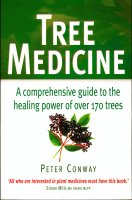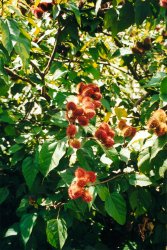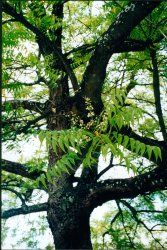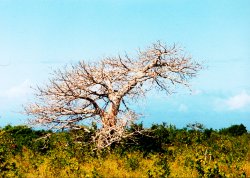
Book
Reviews
Book 32
Conway,
Peter (2001): Tree Medicine
pub. Piatkus (London) ISBN 0 7499 2273

Copyright ©
Tony Burfield Feb 2005.
Peter Conway is a medical herbalist and the author of this 313 page book,
which is divided into two parts: the first hundred-odd pages exploring the
history and nature of tree medicines, the second offering profiles of 170
different trees which can be used for their medicinal properties. The book is
very readable and extremely comprehensively (I was going to say ‘logically’)
presented, generally exploring all angles of the topic under investigation, as
seen from a herbalist’s perspective, and without being pompously
over-scientific.
The nature of tree medicine in Part 1 is approached via five different
chapters the first covering their nature, safety and uses. The second history
chapter covers the exploitation of tree products, quoting many examples such as
chinchona and yew trees (for taxol). Conway, being rather polite and inoffensive
about the subject, chooses not to mention the issue of the possible biopiracy of
ethnobotanic medicines by pharmaceutical companies and stripping bare of lands
of useful medicinal species – quite a strange omission considering the
thoroughness of other sections of the book. A slightly fuller account (by this
author) of the taxol saga for example, and its opportunist exploitation from
Himalayan yew, which was almost wiped out in the process, can be viewed at http://www.users.globalnet.co.uk/~nodice/new/bollocks/bollart12.htmIt.
It isn’t until later in the book that we see (p 109) a muted acknowledgement
of problems in this area when we read that “the situation is improving with
the recognition of intellectual property rights and an increasing tendency to
reward individuals, and more importantly, whole communities.” So, is the
bio-imperialism culture so benevolent that it will occasionally give crumbs away
from the rich mans table? I doubt it, on the evidence so far.
Chapter 5 – medicinal trees at risk – makes some amends, since it deals
with the consequences of tree loss, gives several examples of those species at
risk, and suggests what we can do about it on various levels (personal, group,
national, international). The acknowledgements section mentions the contribution
of Sara Oldfield of the Global Trees Campaign to this excellent chapter, which
is a high-point in the book.
The second part of individual monographs covers familiar and not-so-familiar tree species in a format that includes an overview, active phytochemicals, actions, indications, preparations and cautions. As a quick reference before exploring deeper, or for the casual reader, these monographs give an idea of the possible range of the subject, and some of the associations of remedies with particular species. Less familiar species from the Andes (Guarea rusbyi), SA rainforest (Guazuma ulmifolia, Ptychopetalum olacoides), China (Phellodendrum amurense) etc. make me wonder if I will ever encounter these items in my lifetime, whereas others such as Benzoin (Stryax benzoin), Peepul tree (Ficus religiosa), the Neem (Azadirachta indica) and Annatto/the Lipstick tree (Bixa orellana)– see images below
 |
 |
|
|
Annatto Tree |
Neem Tree |
- are familiar to most people. Again, several monographs further mention the endangered status of the trees – for example Pterocarpus marsupium (Malabar kino or Red Sandalwood) and Phellodendrum amursense (Amur cork tree).
The
Baobab tree Adansonia digitata also has a mongraph, being used in Africa
for fevers and diarrhoea – and provides
an excuse for me to post an image of these amazing trees that I took in
Zanzibar!

The book contains a useful glossary, bibliography
and excellent list of useful addresses (“resources”). My feeling is that for
many people interested in the herbal medicinal area, this volume would be a
useful reference and perhaps enough by the way of information on most topics –
certainly the book accomplishes the task it set out to achieve. But although
Conway (p. 4) hopes we enjoy our walk through the healing forest, “The
Healing Forest*” it ain’t!
* The Healing Forest – Medicinal and Toxic Plants of North West America
by Richard Evans Schultes & Robert F. Raffauf.